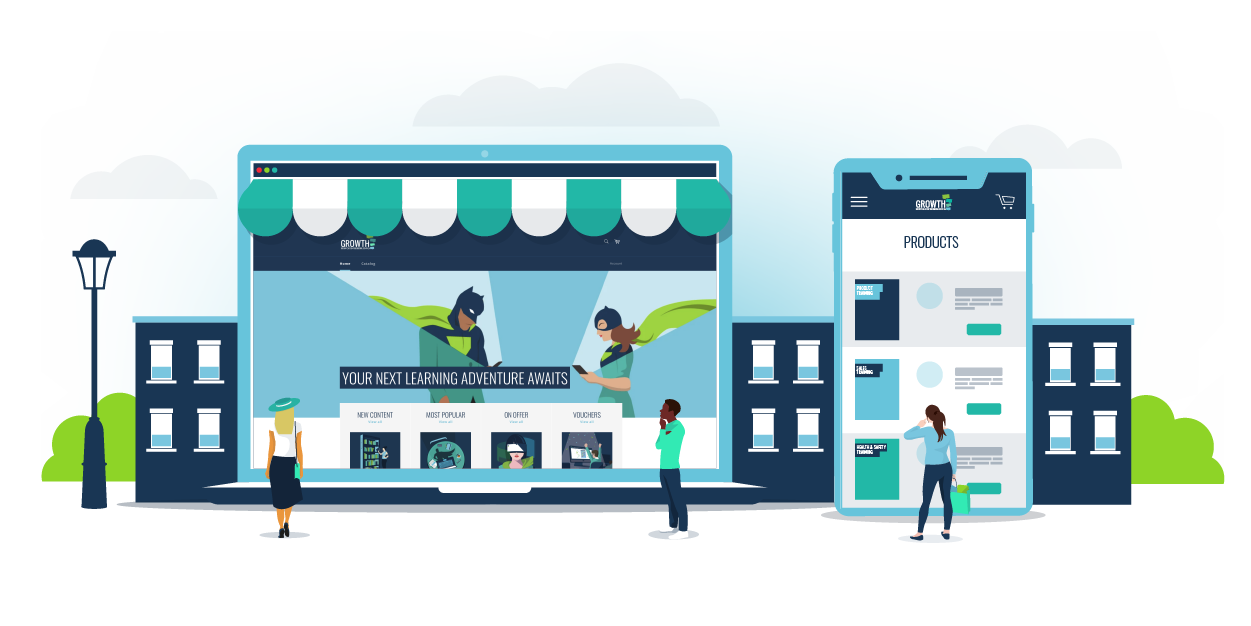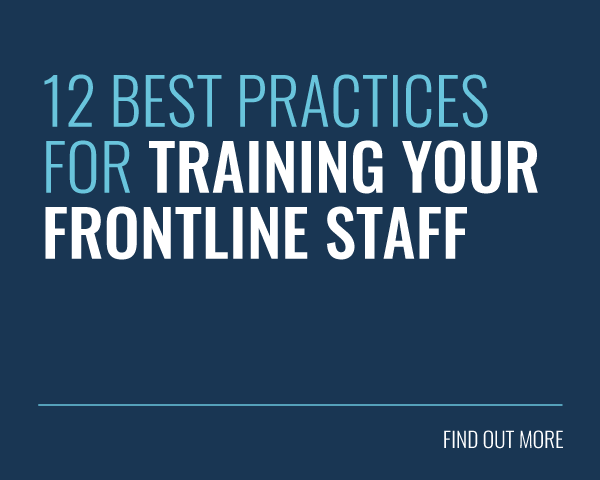 All learning and development (L&D) initiatives come with a price tag. After all, you need a team to create high-impact learning and tools to deliver it to your learners.
All learning and development (L&D) initiatives come with a price tag. After all, you need a team to create high-impact learning and tools to deliver it to your learners.
Considering all the costs related to L&D, it becomes clear you need to ensure your revenue makes it all worthwhile. No organisation has bottomless pockets to waste money on training programmes that do not create the desired impact.
With this in mind, let’s explore how to take your L&D programme and turn it into a revenue-generating engagement engine!
Increasing L&D Needs with Shrinking Budgets
L&D has been in the spotlight for decades, but its importance has become even more apparent in recent years as the working world has shifted drastically.
Now, organisations are investing more and more in employee training. In the UK, employers invest around £41 billion in employee training annually. The average spend per employee reaches just over £1,500 in the UK and £1,111 in the US.
These are high figures for most organisations, which makes it essential for your training programme to create a serious return on investment (ROI). However, outdated approaches, lacklustre tools and wishy-washy strategies have caused a surge in ineffective training programmes.
These unfulfilled expectations have given employee training a somewhat poor reputation. Similarly, organisations still struggle to prove the ROI of their training programmes. As a result, L&D initiatives are still one of the first business areas to suffer from budget cuts if the need arises.
COVID-19, for instance, caused the total training expenditure per learner to reduce by almost half between 2019 and 2021. This is alarming, as six in ten workers say that the pandemic increased their need for new skills.
This has caused a tricky situation. There is a clear need for L&D initiatives and employee training. However, in most cases, there are also fewer resources to commit to high-quality training, whether that’s due to smaller teams or shrinking budgets.
As such, you need to become more focused on generating the best impact and making the most of your resources. Luckily, there are still various ways to optimise your training programme!
Making Your Training Programme More Cost Effective

Turning your L&D programmes from cost centres into revenue generators isn’t easy. After all, sprinkling engagement features or creating libraries full of training content often sounds like a good strategy – but it rarely is. At least not without a plan.
Luckily, there are some tactics you can use to ensure your training programme is as cost and resource-efficient as possible.
Some of these strategies will require changes in your overall training approach, making them a longer-term endeavour. However, there are also quick and easy ways to ensure you are cutting unnecessary costs and optimising your L&D initiatives.
Let’s have a look!
Improve Your Strategies
1. Assess Your Learning Needs
Throughout our years in the industry, we have seen many training programmes that fail to generate revenue simply because there is no clear picture of what the training needs to achieve.
Organisations create content they assume is relevant to their learner audience and craft training programmes based on industry trends or previous experiences. This, however, can lead to aimless training experiences that fail to generate meaningful ROI.
After all, your L&D initiatives will end up being a waste of time and money if they don’t produce the results you desire. You will see engagement go down, too, because no one wants to complete irrelevant content for hours on end.
To prevent this, you need to start your L&D process by conducting an analysis of your skills gaps. That’s where training needs analysis (TNA) comes in. It helps you to find out the unique needs of your learners.
As a result, you can eliminate any costs associated with creating irrelevant training content. In addition, you will see your learners’ skills improving as you are providing effective and useful training they can put into practice straight away!
2. Adopt an eLearning Approach
Did you know that for every $1 invested in online learning, organisations can boost their productivity by $30? When it comes to optimising your L&D costs, online learning can be a game changer.
But where do these cost-savings come from? While implementing online learning can have a higher upfront cost, you can eliminate investments related to training sites, instructors, printing, travel, accommodation, and even catering.
Similarly, your ‘opportunity costs’ will go down. After all, you no longer have to take your workers off the proverbial ‘shop floor’ for hours. Instead, they can complete training when it’s convenient.
However, that’s not where the real savings come from. You can wave goodbye to long instructional design processes by using effective tools like Growth Engineering Authoring Tool. You will have one place to create, design, develop, deploy, update, circulate and analyse content. Simple!
Similarly, it’s a visually stimulating and more interactive way to learn, which makes eLearning more effective. For example, IBM found that students learn 5x more with online learning compared to traditional training methods.
3. Leverage Microlearning Strategies
Traditional training can be time-consuming to both create and complete. This can snowball into other issues that limit the effectiveness and popularity of your training programme.
For instance, creating longer content keeps you away from other tasks. Similarly, your content creation processes are slower and typically more expensive if you need to hire a third-party provider to keep up with your training content needs.

Furthermore, longer training sessions keep your employees away from their work for a protracted period of time. This can lead to both lost productivity and reduced efficiency.
These reasons are enough to reveal why we love microlearning here at Growth Engineering. Microlearning is a strategy where you deliver training content in bite-sized chunks.
These short units typically take under 10 minutes to complete, which helps you to cater to your learners’ attention spans. In addition, microlearning content is often more appealing to your modern learners as it makes training quick, easy and flexible to consume.
4. Incorporate Gamification
Another great way to make your training programme more cost-effective is to use gamification. Gamification means adding game mechanics into non-gaming environments to make them more palatable and fun.
As a result, gamification can have a big positive impact on learner engagement. This means your learners will be hungry to explore your training initiatives and you won’t need to spend time or money on engagement tactics!
In addition, learner buy-in means your learners will enjoy their training programme. The more content they explore, the better equipped they will be in their roles. This can be seen in increased productivity or efficiency.
As such, gamification can be a key tactic in making or breaking your training’s ROI. And the good news is that most of today’s modern learning platforms, like Growth Engineering LMS, cater to gamification. This is impact made easy!
5. Encourage Social Learning
Your intellectual capital is the bread and butter of your organisation. After all, your company’s financial capital would cease to exist without the pool of knowledge, experience and skills within your organisation.

While this makes adequate skills development extremely important, it also brings big benefits for your training programme. In fact, if we are to believe the 70:20:10 Model, 20% of all we learn happens through social interaction.
As such, you can make your training programme more cost-effective and generate better ROI by encouraging knowledge sharing and user-generated content (UGC). You can do this by introducing social learning features, such as Clubs or Social Feeds.
You can incorporate this expertise into your training programme by creating modules based on what your learners are discussing in their Clubs. What better way to learn than by exploring real-life experiences, case studies and strategies?
6. Focus on Upskilling
Did you know that employees are more likely to stay in an organisation that provides opportunities for employee development? This alone makes employee training business critical.
After all, the average employer spends £3,000 and 27.5 days to hire a new worker. As a result, poor L&D costs the UK economy alone over £2.4 billion in rehiring costs.
This is a lot more than the average training costs per employee per year. Similarly, you need to provide appropriate onboarding training for these new employees, which ups the costs further.
As such, offering upskilling and reskilling for your employees is a great way to cut overall organisational costs and focus on the most relevant aspects of your training. In fact, upskilling and reskilling recently topped Donald H. Taylor’s global L&D sentiment survey for the second year in a row.
In addition, demand for new skills has increased after COVID-19 changed the business landscape. Upskilling and reskilling training helps you to make a more productive workforce while meeting these new skills needs.
Cut Unnecessary L&D Costs
1. Pick the Right Tools and Approaches

When creating a fancy new training programme, it may feel like you need all the shiny tools to go with it.
As a result, companies are investing in learning platforms, authoring tools, web conferencing and video editing software, game templates and data analysis tools to have all systems in place.
Unfortunately, all these tools come with a price tag. Similarly, it’s likely your instructional designers will feel overwhelmed by all the new software they need to learn to create a simple learning unit.
Luckily, in most instances, you won’t need fifteen different tools to create awesome L&D initiatives. Combining your approaches can be an excellent way to reduce your spending, all while streamlining your processes and saving precious time.
For example, one learning ecosystem, like Growth Engineering Impact Suite, typically includes all the tools you need to create, deliver and analyse your training programmes. Better still, this purpose-built solution comes with features that help you to make your training as engaging and high-impact as possible.
2. Plan Your Content in Advance
As we explored in the previous section, any revenue-generating L&D project starts with a well-thought-out plan. Working out all the details before you start creating your courses helps you to avoid unnecessary and surprising expenses.
This is also true when it comes to your content. Your training needs analysis helps you to evaluate what modules you need to deliver to bridge any current skills gaps your learners are contending with.
Similarly, it will help you to determine the best structure for your learning programme. After all, your content needs to get progressively harder to create the best outcomes.
Then, you need to decide what methods or tools you are going to use. After all, not all content formats suit all methods. Following a content calendar is an excellent way to ensure you are creating the right content at the right time.
Ultimately, this means that you are not wasting your time or resources. Instead, you are following a carefully crafted plan that highlights each team member’s responsibilities, time frames, content formats and estimated workload.
3. Make Use of Templates
Creating new content and course material is a key part of building a training programme. Unfortunately, it’s also a time-consuming process.
Luckily, there are multiple ways to reduce spending too much time or budget on content creation without compromising the quality. One way to do this is to make use of templates instead of building each content unit from scratch.
Most authoring tools come with built-in eLearning templates. You can tweak these templates to fit your content needs before saving and reusing them for other courses.
To streamline the process even further, you can create a library of assets that holds your content templates, as well as any useful videos, images, audio files or logos. This ensures design consistency while making the process quicker than before.
4. Rally Your SMEs
Typically, your employee training needs to tackle various topics and pain points at different seniority levels.
As a result, developing in-house training materials can become time-consuming and difficult. After all, your knowledge may have limitations, especially when it comes to more senior levels of training.
To make this process easier, you should make good use of the subject matter experts (SMEs) you have in your organisation. This will help you to cut down on L&D costs as you don’t have to hire outside professionals while making the process quicker.
What is essential, however, is to ensure that your training remains high quality. It’s likely that your SMEs are not experts in instructional design or creating training materials.
The best way to maintain quality is to review any past training materials you have on the topic. Providing your SMEs with a detailed outline or specific questions helps you to create training that’s relevant to your audience.
5. Outsource When Needed
While taking advantage of the knowledge you have in-house is essential, you should not shy away from outsourcing when needed.
For instance, you may find that you don’t have a subject matter expert on a specific topic of great importance. As a result, it may become more cost-efficient to hire third-party experts instead of spending hours trying to master a topic yourself.

Similarly, outsourcing may be a viable option if you have a small eLearning production team. After all, outsourcing means you can get the bulk of the time-consuming development process done while focusing on other responsibilities, like course promotion or administrative tasks.
Once you have this outsourced content, it’s easy to use your authoring tool to take care of minor updates or changes according to your needs.
6. Analyse Your Data
Lastly, you should pay close attention to your data. After all, it’s the key to knowing what to cut, where to pivot and where to allocate your resources.
Ultimately, your data helps you to understand what’s working and what’s not. Based on your analysis, you can wave goodbye to unnecessary tools, optimise your content creation, plan more cost-effective engagement tactics and ensure you have the right people in your L&D team.
Deloitte found that businesses with strong data-driven insights and decision-making are twice as likely to exceed their business goals. As such, your data-driven approach can produce cost savings and improved productivity in other areas of your organisation.
Generating More Revenue Through L&D
We have looked at ways to optimise your costs and resources, but there are also ways to generate more revenue through your L&D efforts. These approaches may not suit every organisation, but will give you an idea of what’s possible through a high-impact training programme.
1. Implement eCommerce

eCommerce is the buying and selling of goods or services via a computer network. These online ‘storefronts’ rose to prominence in the late 90s and are now an integral part of the internet.
Considering its popularity, it only makes sense that eCommerce has also spread into the world of online learning. Now, organisations use eCommerce features on their learning platforms and L&D programmes to gain more revenue from their content creation efforts.
After all, eCommerce allows you to sell your courses through your platform or a third party to your core or secondary audiences. For instance, Growth Engineering LMS enables you to create a store, manage your catalogue and sell courses all in one place.
Your eCommerce site is fully customisable to look like your brand, payments are secure, and you can even create subscription models to boost sales. As a result, you can gain additional revenue on the courses you would create for your internal audience anyway.
2. Provide Extended Enterprise Training
Employee development alone is a worthy investment. However, you can drive more value by broadening the scope of your training.
As companies continue to compete in more demanding and crowded marketplaces, it has become common for organisations to train people who are not a direct part of their workforce.
This group of learners is also known as your extended enterprise. It covers your wider network of customers, suppliers, resellers, partners and other interconnected parties.
Ultimately, providing extended enterprise training helps you to improve your competitiveness. After all, your external stakeholders have a great influence on your organisation’s bottom line.
You can expect, for example, more efficient onboarding, increased engagement, lower demand for your support teams and supercharged productivity, leading to lower L&D costs and a boost in revenue.
3. Communicate Your L&D Success
Communicating your successes and highlighting your revenue is the only way to change how L&D is viewed within your organisation. And the better buy-in you get from your leadership team, the better organisation-wide engagement you can expect.
You can do so by using data and providing clear ROI details. In fact, data is your best bet to showcase how well your training is meeting your learning objectives.

You should, for instance, compare improvements every quarter and provide clear reports on the results. Highlight where your programmes have made a meaningful impact on your business. And don’t be afraid to try and spell this out in financial terms.
As a result, L&D will move from being a box-ticking exercise into a continuous learning culture. This will lead to increased engagement and productivity as your learners will be hungry to explore their training content and improve their skills.
Simultaneously, you can enjoy better L&D budgets as your leaders see the real value and possible revenue of your training initiatives.
Final Words
Employee development is more important than ever before. The global pandemic and the speed of digital transformation have drastically changed the business landscape. This has brought along new challenges as employees need to update their skill sets.
Unfortunately, many organisations struggle to see the fruit of their L&D labours. Often, organisations create irrelevant or unengaging training that fails to improve their employees’ productivity.
In addition, smaller L&D budgets have made it more difficult to optimise training programmes for the best results and biggest revenue. As such, you may be left with a training programme that eats all your budget without giving much back.
Luckily, our tips help you to transform your L&D strategy from a cost centre to a revenue generator. Soon, you will have a high-impact training initiative that both your learners and finance team will love!
Learner engagement is key to a successful training programme. Our ‘150 Nifty Learner Engagement Tips’ is your one-stop shop for upgrading your engagement strategy!






